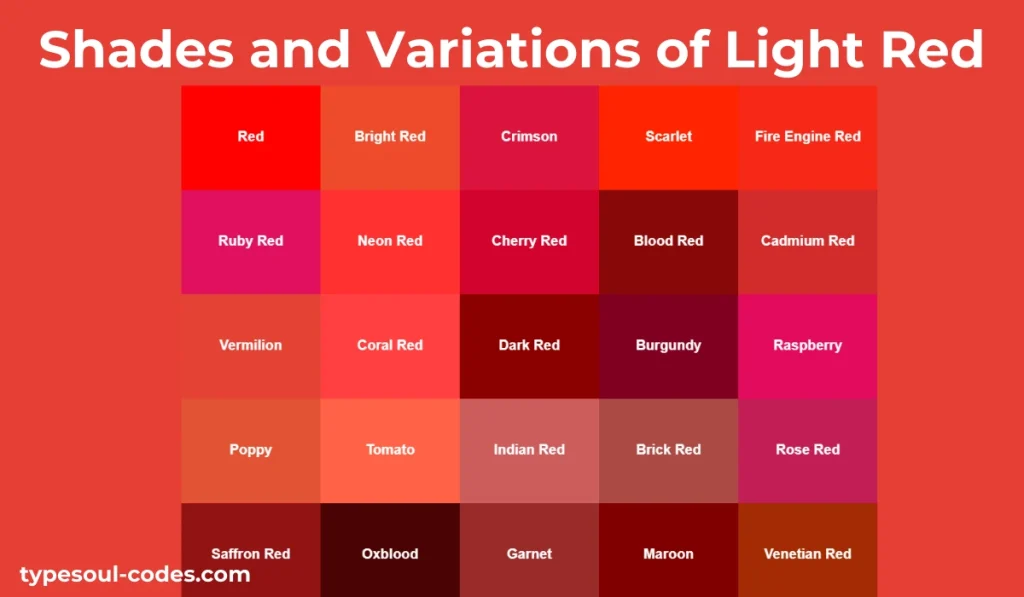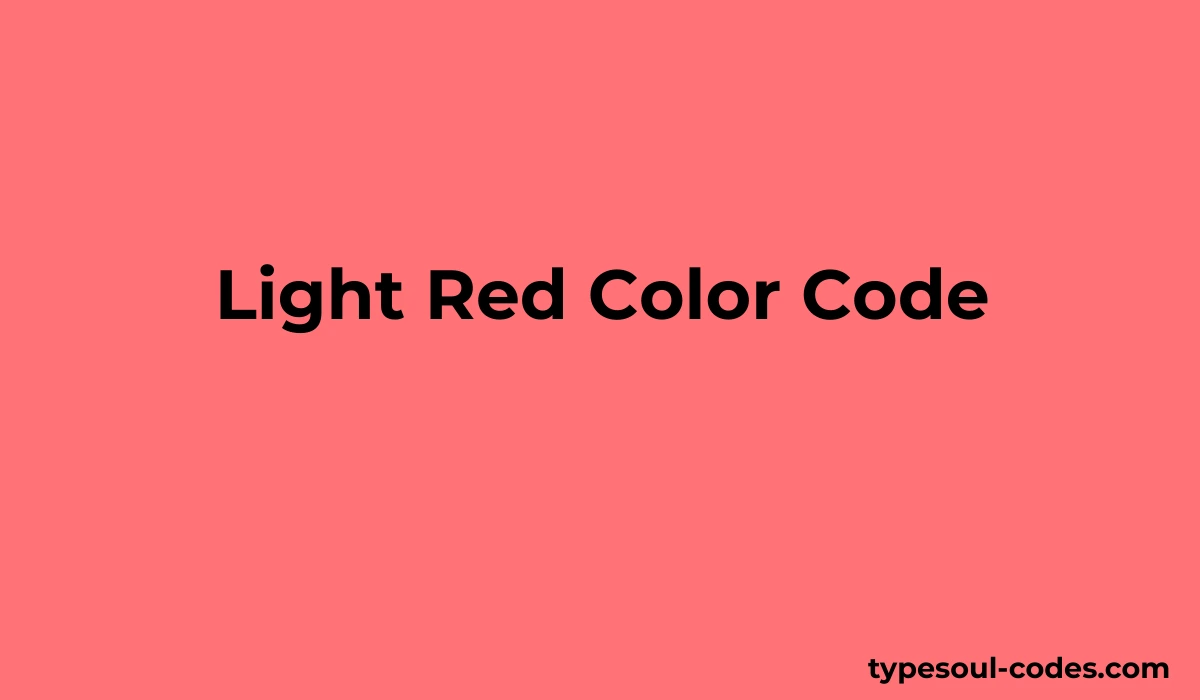The Light Red Color Code is essential for artists, web designers, and print experts. This color is often mistaken for pink at first glance, but it has a bold and energetic identity. Unlike pale pink, light red holds a strong warmth and clarity, which keeps it visible in both digital and natural light.
Understanding the light red color code helps maintain color consistency in branding and design. This soft version of red blends passion with playfulness. It carries the energy of red but appears more approachable due to added brightness. This article will guide you through the technical aspects and creative use of this lively color.
What is the Light Red Color Code?
The light red color code varies slightly depending on its shade and context. The most commonly accepted version in digital spaces is:
| Model | Value |
|---|---|
| Hex | #FF7276 |
| RGB | 255, 114, 118 |
| CMYK | 0, 58, 41, 0 |
| PMS | 805 C |
This hex code gives a soft, balanced light red suitable for modern designs. The RGB model uses full red and balanced green and blue to tone the shade. The CMYK values make it easy to recreate in print. Each format plays a role in how the color is used across different design fields.
Why Use Light Red in Your Design?
Designers use light red color code to express warmth, charm, and a little excitement. It is often seen in fashion, web UI design, marketing material, and social media graphics. This color draws attention without overwhelming the viewer. In brand storytelling, it adds emotion while keeping the message clear.
In children’s products or food packaging, light red can create feelings of fun and joy. For tech brands, it softens the harshness of bright red. Many websites now use it in buttons or banners to increase engagement without causing distraction. Because it blends well with soft tones and bold backgrounds, it works for both light and dark themes.
Light Red vs. Pink: Know the Difference
It’s easy to confuse light red with pink, but they are not the same. Pink contains blue or purple undertones. On the other hand, light red has orange or yellow undertones. This means pink feels calm and romantic, while light red feels active and uplifting.
If you’re working on a website, pink may suit a soft theme, but light red adds life. It also looks richer on screen and in print when contrast is needed. That’s why knowing the exact light red color code helps keep your design goal on track.
Read more: Maytag error codes
RGB and HEX Details of Light Red
Here is a deeper look at the digital side of the light red color code:
| Model | Code |
|---|---|
| HEX | #FF7276 |
| RGB | 255, 114, 118 |
| RGB % | 100%, 45%, 46% |
| Decimal | 16741558 |
These numbers are used in CSS, web design, mobile apps, and graphic editors. Using the right code ensures your shade doesn’t change when viewed on different screens. Consistency is key in branding and user interfaces.
CMYK and Print Uses of Light Red
The CMYK format is critical in professional printing. Below are the values used in print jobs:
| Model | Value |
|---|---|
| CMYK | 0, 58, 41, 0 |
This shows that light red uses no black (K) and is print-friendly. The values make it ideal for magazine ads, flyers, or packaging. When using large format printers or offset printing, exact CMYK values prevent the shade from turning orange or coral.
Shades and Variations of Light Red

Designers often explore slight shifts in the color spectrum to find the best version. Below are variations based on the light red color code:
| Shade Name | Hex Code |
|---|---|
| Light Red | #FF7276 |
| Bright Light Red | #FF6961 |
| Soft Light Red | #FFA07A |
| Deep Light Red | #FF4500 |
| Pastel Light Red | #FFDAB9 |
Each shade offers a unique emotion. Lighter tones feel friendly and airy, while deeper tones feel passionate and bold. You can choose a variation based on your design’s mood or message.
Color Combinations for Light Red
The light red color code pairs beautifully with many shades. In design, it contrasts well with navy, white, or dark green. The table below shows colors that balance well with light red:
| Pairing Color | Hex Code | Mood it Creates |
|---|---|---|
| Mint Green | #66FFE5 | Fresh and energetic |
| Navy Blue | #000080 | Bold and professional |
| Cream | #FFF0F3 | Soft and friendly |
| Charcoal | #333333 | Modern and serious |
These combinations are useful in layouts, logos, or even room designs. Using complementary colors improves contrast and readability while keeping the vibe pleasant.
Applications of Light Red in Real Life
The light red color code appears in several industries. In fashion, it’s found in spring and summer collections. In tech, it’s used in call-to-action buttons. Packaging, it draws attention without shouting.
Social media posts using light red often see higher engagement. This is because the color is visually appealing and easy to notice. Many brands also use it in seasonal campaigns, like Valentine’s Day or holiday offers.
Read more: What area code is 651
Psychological Meaning of Light Red
Colors impact emotion, and light red is often tied to love, excitement, and enthusiasm. It encourages action but in a calm and friendly way. Brands that want to appear vibrant yet caring often use this shade.
In wellness or skincare brands, light red brings warmth without aggression. In education platforms, it adds creativity and encourages attention. Choosing the right color creates an emotional connection.
Color Swatch Sample: Light Red
If you’re building a palette, here’s how light red might look among other swatches:
| Color | Hex Code |
|---|---|
| Light Red | #FF7276 |
| Coral Pink | #FF94AB |
| Dusty Rose | #E6676B |
| Warm Beige | #FFDDE4 |
| Dark Maroon | #500012 |
This table gives a sense of how light red can anchor a palette with a mix of vibrancy and softness.
Frequently Ased Questions
What is the hex value of the light red color code?
The hex value is #FF7276. It creates a soft, warm version of red ideal for designs.
Is light red the same as pink?
No, light red is warmer and more vivid. Pink has blue tones, while light red leans toward orange.
How do I use the light red color code in CSS?
You can use it in CSS like this:background-color: #FF7276;
What color goes well with light red?
Navy, mint green, cream, and white all complement light red in web and print design.
Conclusion
The light red color code gives you creative power in both digital and print projects. Whether you’re designing websites, posters, or fashion pieces, this color brings a perfect mix of energy and softness. With the hex value #FF7276, designers can control brightness and warmth effectively. Remember, picking the right shade isn’t just about looks—it’s about creating an emotion. When you understand the color code, you gain full control over your message and mood.
Do you want a custom light red palette for branding or UI design?

